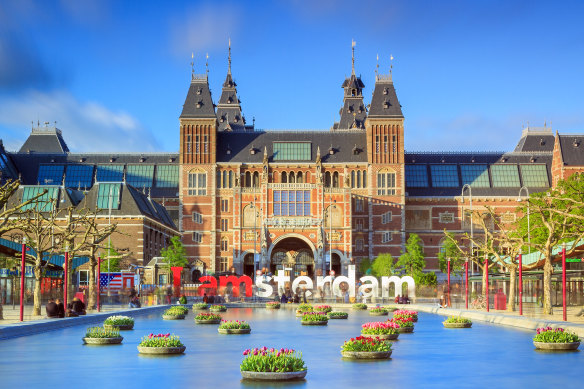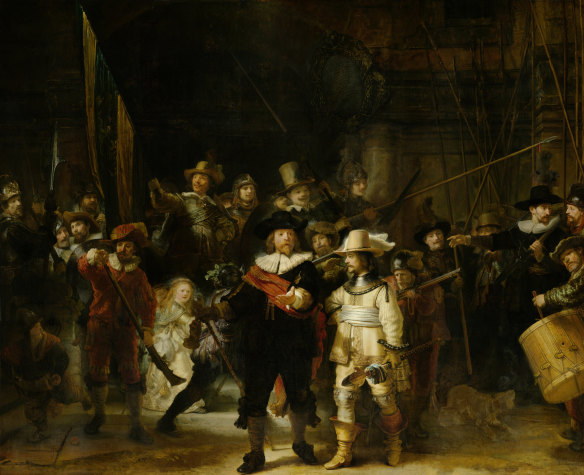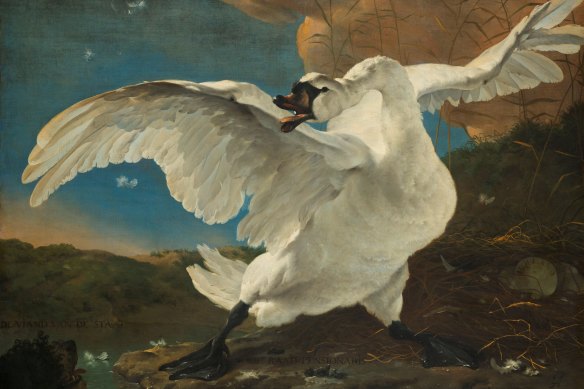Amsterdam’s iconic art museum is like no other in Europe
Seven wonders of Amsterdam’s Rijksmuseum

The existence of a public-access bike underpass through the Dutch national museum of history and arts might be a novelty for tourists, but for Amsterdamers, its continued existence reflects the fight to keep the city livable for locals.Credit: iStock
From blockbuster paintings to cabinet curios and even a bike tunnel, the Rijksmusem is like no other art museum in Europe.
Rembrandt’s The Night Watch

The Night Watch by Rembrandt.
Centrepiece of the second floor’s Hall of Honour, Rembrandt van Rijn’s The Night Watch is the museum’s star attraction. Rather than remove it for restoration, in 2019 the museum initiated Operation Night Watch, enclosing the painting in a glass box and beginning the work in full public view. With the gilded frame removed, one of the world’s best-known paintings is stripped bare – visitors get a rare glimpse of the exposed frayed edge of the canvas.
Rachel Ruysch’s still life
Women are heavily underrepresented in art history, an issue the Rijksmuseum tried to remedy in 2021 by adding works by three female artists to the permanent display in the Gallery of Honour. One of them is Dutch artist Rachel Ruysch’s Still Life with Flowers in a Glass Vase, a darker, detailed artwork painted between 1690 and 1720. One of the most successful female painters of her time (her artwork fetched more than Rembrandt usually received), she signed her work with her own name. The mother of 10 continued to pursue her art well into her 80s.
Stern of the Royal Charles
The scale model of the warship William Rex almost steals the show in the Naval rooms, but save some admiration for the stern carving from the Royal Charles. The pride of the English fleet, the Royal Charles was captured during a Dutch raid on the port of Chatham in 1667. Taken back to the Netherlands as a spoil of war, the ship was scrapped. The intricately carved coat of arms from the stern, weighing more than 600 kilograms and almost four metres wide, was kept for posterity as a reminder of one of the country’s most spectacular naval victories.
Special collections
Most visitors head for the second floor, but the odd layout of the Rijksmuseum means they often miss the special collections on the ground floor, which are obscured by the coatroom, toilets and a souvenir shop. Among the quirky and unique items are shipwreck relics, hand-painted instruments, delicate silver miniatures, illuminated dioramas and centuries-old costumes. The armoury has bejewelled knives, elaborately decorated cannon and flintlock pistols with carved ivory grip and stock.
Apothecary miniature
Much fuss is made about the Rijksmuseum’s 17th-century dolls’ houses, but the gentleman’s equivalent on the first floor deserves equal praise. Here, an unassuming antique cabinet opens to reveal 300 thimble-sized casks, pots and delft blue bottles filled with ingredients used by 18th-century chemists (including arsenic, scorpion oil and snake venom) in a traditional apothecary-store set-up. Adorned with tiny paintings and a small shrine, it has 55 compartments containing more than 2000 organic species, including seeds, plant roots and flowers.
The Threatened Swan

Whether or not you’ve disturbed a nesting swan, it’s hard not to be drawn to Jan Asselijn’s dynamic, dramatic canvas. A furious, life-like swan rushes to protect its eggs from a small dog. The painting becomes more significant once you discover it was the landscape painter’s only depiction of an animal, and a political allegory for revered Dutch statesman Johan de Witt, who was assassinated in 1672.
Bike passage
The existence of a public-access bike underpass through the Dutch national museum of history and arts might be a novelty for tourists, but for Amsterdamers, its continued existence reflects the fight to keep the city livable for locals. It faced demolition when the museum closed for a 10-year renovation in 2003, but a lobby group of bike commuters successfully agitated to keep the passage open. Today, it serves as a museum entrance – and a theatre for spectator sports as cyclists and unwary pedestrian tourists meet.
The writer visited as a guest of the Rijksmuseum
Sign up for the Traveller newsletter
The latest travel news, tips and inspiration delivered to your inbox. Sign up now.